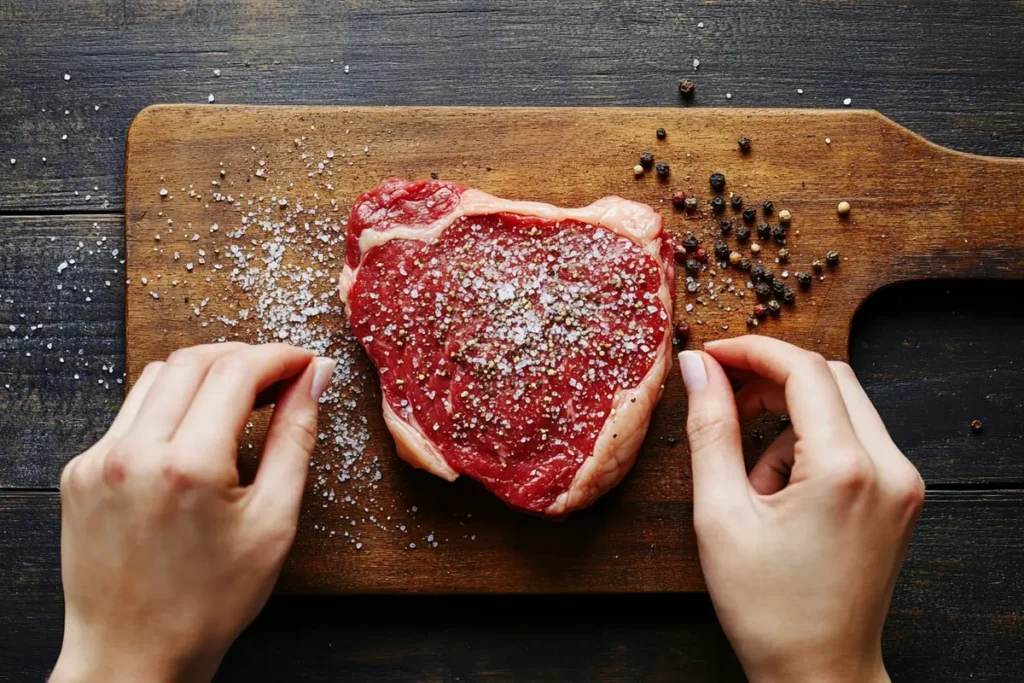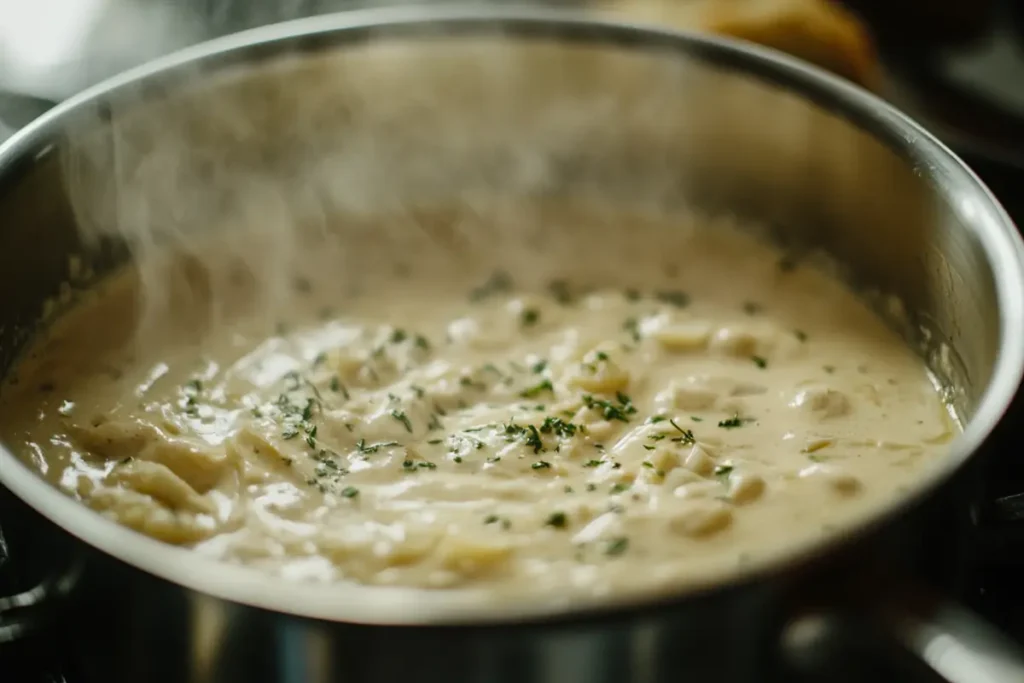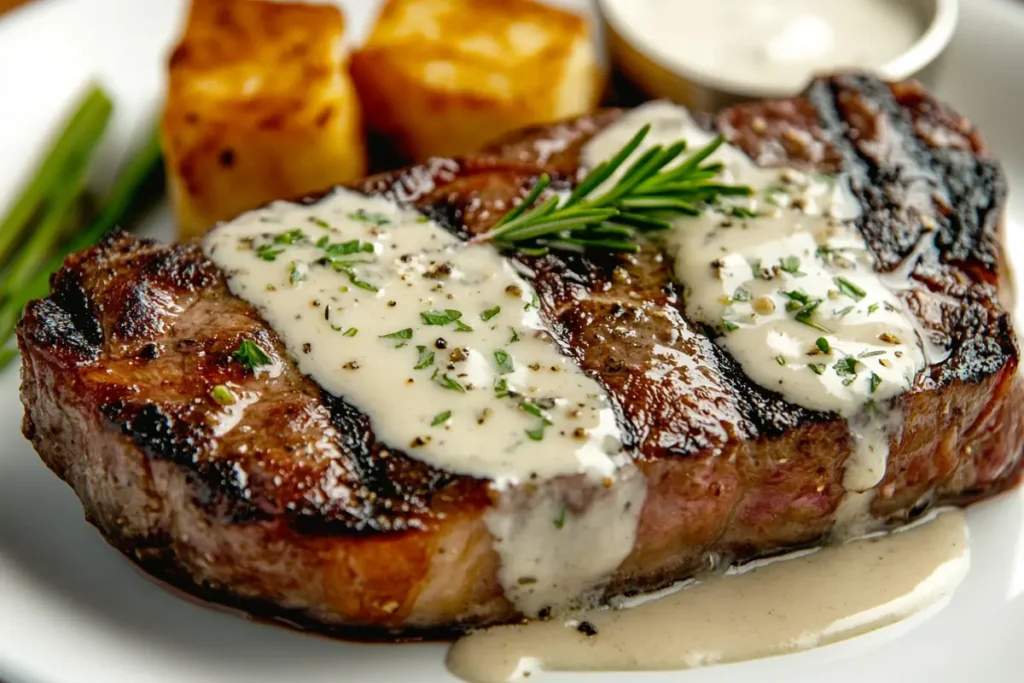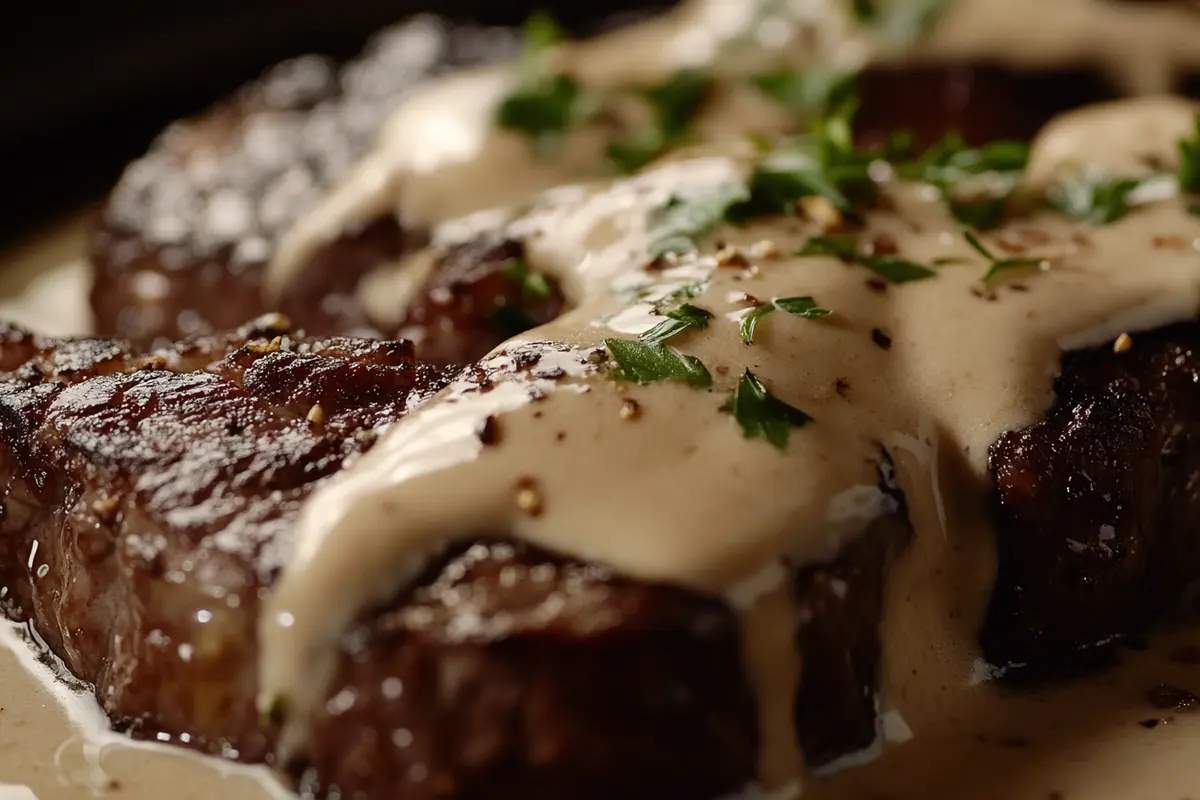Craving a truly naturally juicy steak? This recipe delivers a perfectly cooked steak with a rich and savory creamy garlic sauce. Learn how to make it easily.
The Secret to a Naturally Juicy Steak
Many people love a good steak. However, cooking it well can seem hard. The secret lies in the quality of the meat. Choose a cut that’s naturally well-marbled. This means it has streaks of fat throughout. Fat adds flavor and keeps the steak juicy. Also, remember to season generously. Use salt and pepper. This brings out the natural taste of the beef.
Choosing the Right Cut of Beef
For the best result, pick a steak that is about one to one and a half inches thick. Ribeye is a great choice. It is well-marbled. New York strip is also good. It is leaner but still flavorful. Sirloin is another option. It is more affordable. The best steaks are naturally tender. Therefore, the cut makes a big difference. Moreover, considering different cuts can enhance the overall cooking experience. A well-chosen steak is the first step to culinary success.
Proper Seasoning for a Naturally Juicy Steak

Seasoning is very important for a delicious steak. For example, use coarse salt. This helps to form a great crust. Freshly ground black pepper is also important. Therefore, don’t be shy with the seasoning. Season all sides of the steak. This ensures even flavor. Naturally, simple seasonings work wonders. Indeed, the quality of the salt and pepper also influences the outcome. A good quality seasoning elevates even the best steak.
Making the Naturally Creamy Garlic Sauce
A great sauce elevates a good steak. This creamy garlic sauce is very easy to make. It has a rich and savory flavor. It naturally pairs very well with steak. The main ingredients are butter, garlic, cream, and some herbs. This combination creates a wonderfully smooth sauce. Furthermore, the sauce adds a depth of flavor. It transforms the steak into a gourmet experience.
The Base of the Garlic Sauce: Butter and Garlic
First, melt butter in a pan. Use medium heat for this. Add minced garlic next. Cook the garlic until it’s fragrant. Be careful not to burn the garlic. Burnt garlic tastes bitter. This is the natural start of the sauce. It sets the flavor. Consequently, controlling the heat is essential at this stage. The garlic’s aroma should fill the kitchen with anticipation.
Creating the Creamy Texture

After cooking the garlic, add heavy cream. Stir it well into the melted butter. Allow the mixture to simmer. This will allow it to thicken naturally. Add a little salt and pepper. Then, the sauce begins to come together. It becomes smooth and creamy. Likewise, adding the cream slowly and stirring constantly prevents any separation. The gentle simmer ensures the sauce thickens evenly.
Adding Herbs for Flavor Enhancement
Finally, add some fresh herbs. Parsley and thyme are good choices. These herbs add a fresh taste to the sauce. Naturally, you can use dried herbs if you do not have fresh ones. Add them towards the end of the cooking process. This allows the flavors to infuse. Alternatively, a pinch of dried oregano can add a different dimension. Fresh herbs, however, bring a brighter, more vibrant taste.
Cooking the Steak: A Step-by-Step Guide
Cooking steak correctly is essential for the best results. The goal is to have a nice crust on the outside. Also, the inside should be cooked to your liking. There are several ways to cook steak. Pan-searing is a popular choice. Grilling is another common method. However, the steps are similar for each. Accordingly, the method chosen can impact the final texture of the steak. Both searing and grilling, when done right, yield great results.
Preparing Your Pan or Grill
Before cooking, heat your pan or grill. A hot surface ensures a good sear. For pan-searing, use a cast-iron skillet. This helps create a great crust. Allow your pan or grill to get very hot. This will help cook the steak evenly. This naturally sears the outside of the steak. Moreover, preheating is key for even cooking. A hot surface prevents the steak from sticking.
The Searing Process for a Great Crust
Place the seasoned steak on the hot surface. Don’t move it for a few minutes. This allows the crust to form. Sear each side well. Sear it for about three to five minutes per side, depending on the thickness. This step is very important. It creates the natural flavor. For example, do not flip the steak too soon, this is essential for a proper sear. A good crust is not only about looks but also about locking in the juices.
Testing for Doneness
Use a meat thermometer to test for doneness. For medium-rare, the internal temperature should be around 130-135°F. Medium is about 135-140°F. For medium-well, aim for 140-145°F. A well-done steak is around 145°F and above. These are natural benchmarks. Remember that the internal temperature will continue to rise slightly after cooking. Thus, pulling the steak from the heat a little before the desired temperature is ideal. The carryover cooking effect should be considered.
Letting the Steak Rest
After cooking, let the steak rest. Place it on a cutting board for about five to ten minutes. This allows the juices to redistribute. Therefore, the steak will be more juicy. This makes a big difference. It is naturally the best way to enjoy steak. Furthermore, tenting the steak lightly with foil can keep it warm. Resting prevents the juices from running out when you cut it.
Serving Your Naturally Juicy Steak
Serving a steak the right way is as important as cooking it. A well-presented steak is visually appealing. It is also more enjoyable. The creamy garlic sauce is a key component. Therefore, pair them well. Generally, the plating is just as crucial as the cooking. A well-presented meal stimulates the appetite.
Plating the Steak with the Garlic Sauce

To serve, place the steak on a plate. Then, spoon the garlic sauce generously over it. You can also pour the sauce on the side. This gives people a choice. Garnish with extra fresh herbs. This enhances the presentation. The flavors will naturally combine for a delicious experience. In addition, consider adding a small drizzle of olive oil for an extra touch. This also enhances the visual appeal of the plate.
Complementary Side Dishes
Many side dishes go well with steak. Roasted potatoes are a great option. They are simple to make. A fresh green salad is also good. It adds some freshness. Asparagus, for example, is also a nice side. These dishes naturally complement the steak. Likewise, consider adding some roasted mushrooms for a more robust meal. The choice of side dishes can greatly elevate the overall experience.
Wine Pairings
A good wine elevates a steak dinner. Red wines are often the best choice. Cabernet Sauvignon is a popular option. Merlot also goes well with steak. Consider these natural pairings. It will create a memorable meal. Moreover, a full-bodied red wine enhances the savory flavor of the steak. A good pairing is key for an enjoyable dining experience.
The Importance of Choosing Quality Meat
The type of meat you choose is fundamental to the outcome of your steak. Understanding the differences in cuts can transform your cooking experience. Selecting the right steak is paramount for achieving a naturally juicy and flavorful result. Indeed, consider these points when choosing.
Understanding Marbling
Marbling, the streaks of fat within the muscle, is a critical factor. It impacts both the flavor and tenderness of the steak. Well-marbled steaks are naturally more juicy. They tend to melt during cooking, basting the meat from within. Therefore, look for steaks with visible fat distribution.
Freshness of the Meat
Always choose fresh meat. This is an essential step for a better-tasting steak. Freshness ensures the best flavor and texture. Therefore, check the color and the smell. A fresh steak should have a bright red color and a mild smell. Naturally, avoid steaks that appear dull or have an off-putting odor.
Considering the Source
The source of your meat can also impact the flavor. Consider choosing meat from reputable sources. This can ensure better quality and taste. Therefore, locally sourced meat might offer a superior flavor. Knowing where the meat comes from adds to the experience. It makes a more natural choice for your meal.
Enhancing the Flavor with Different Herbs
While parsley and thyme are excellent choices for the creamy garlic sauce, naturally, there are other herbs to try. Experimenting with different herbs can enhance the flavor of the sauce. This allows you to customize the sauce to your liking. Therefore, it’s worth exploring these various additions.
Rosemary and Sage
Rosemary and sage bring an earthy flavor to the sauce. They pair well with the richness of the cream. Add a small amount of chopped rosemary or sage to the sauce. This will infuse it with a unique taste. Their aroma is strong and adds a touch of the natural outdoors.
Chives and Tarragon
Chives and tarragon offer a lighter flavor to the sauce. They bring a mild, oniony taste. Chopped chives and tarragon give the sauce a subtle, elegant touch. These herbs enhance the overall freshness of the dish. They make a light and natural addition.
Garlic and Herb Butter
Another way to enhance the flavor is to make a garlic and herb butter. This can be added to the steak when it rests. Mix softened butter with minced garlic and your favorite herbs. The butter melts into the steak while it’s resting. This method adds a rich and naturally delicious layer of flavor.
Exploring Different Cooking Methods
While pan-searing and grilling are popular, there are other ways to cook a steak. Exploring different cooking methods can give you different textures and flavors. Each method has its own benefits. Therefore, consider trying these.
Broiling
Broiling is a quick method of cooking steak. It involves cooking the steak under high heat. Broiling creates a nice crust. It also cooks the steak quickly. However, watch the steak carefully to prevent burning. This method is naturally good when you’re short on time.
Sous Vide
Sous vide is a more precise method of cooking steak. The steak is placed in a water bath with controlled temperature. This method ensures even cooking. You can then sear the steak for a crust. Sous vide gives you a very tender and evenly cooked steak. It’s a naturally effective method for consistent results.
Reverse Searing
Reverse searing is a technique that involves low-temperature cooking followed by a sear. The steak is cooked in a low oven first. This allows the meat to cook evenly. Then, you sear it in a hot pan to create a crust. This method gives you a perfect combination of even cooking and a great crust. It’s a natural way to achieve both tenderness and texture.
Tips for Maintaining a Clean Cooking Area
Keeping your cooking area clean is important. This not only makes cooking more enjoyable. It also reduces the chance of cross-contamination. Therefore, follow these tips. They will help to maintain a tidy kitchen while you cook.
Cleaning as You Go
Clean up spills as soon as they happen. This will keep your area neat and organized. Use a damp cloth to wipe surfaces. This will keep the mess from spreading. Naturally, a clean space makes cooking more efficient.
Having the Right Tools
Using the right tools will also help. Have a cutting board, separate for raw meat. Have also a trash can nearby. These can make clean up easier. Having the right set up is a natural help. It helps keeps your kitchen tidy.
Washing Dishes Immediately
Do not leave dirty dishes in the sink. Wash them as you go, if possible. This keeps your kitchen less cluttered. It will make your space more enjoyable. Therefore, making washing dishes part of your process is naturally a great idea.
Understanding Different Doneness Levels
Understanding the different doneness levels is crucial for cooking steak to your preference. The internal temperature of the steak determines the level of doneness. It ranges from rare to well-done. Therefore, understanding this is vital.
Rare
A rare steak has a very red center. The internal temperature ranges from 125-130°F. The steak is warm to the touch. It is tender but also quite juicy. It is a natural preference for many.
Medium Rare
A medium-rare steak has a warm red center. The internal temperature ranges from 130-135°F. The steak is tender and juicy with a great balance of sear. It is a natural choice for many people.
Medium
A medium steak has a pink center. The internal temperature ranges from 135-140°F. The steak is firm but still juicy. It’s a good option for those who prefer less redness. This is a natural option for many.
Medium Well
A medium-well steak has a hint of pink in the center. The internal temperature ranges from 140-145°F. The steak is firm and less juicy. It is a more cooked version. It’s a natural choice for some.
Well Done
A well-done steak has no pink in the center. The internal temperature is 145°F and above. The steak is firm and less juicy. It’s the most cooked version. It may not be naturally the best option for all.
Conclusion: Enjoy Your Naturally Juicy Steak
In conclusion, this steak with creamy garlic sauce is a fantastic recipe. It’s simple to make, yet it tastes so good. The juicy steak, with the rich sauce, is satisfying. It’s the perfect meal for a cozy night in or a special dinner party. So, try it and enjoy this naturally delicious dish. Remember these tips for success. Furthermore, exploring the various options for this recipe can elevate your cooking skills. The journey of cooking is naturally full of learning and delicious outcomes.
Frequently Asked Questions (FAQs)
What’s the secret to a juicy steak?
The secret to a naturally juicy steak lies in the quality of the meat, proper seasoning, high heat for searing, and resting after cooking. Marbled meat helps keep the steak moist. Additionally, allowing the steak to rest allows the juices to redistribute.
How do you thicken creamy garlic sauce?
To thicken creamy garlic sauce, simmer the cream gently over medium-low heat. As the cream reduces, it will naturally thicken. Also, you can add a small amount of cornstarch or flour mixed with cold water to the simmering cream. Make sure to stir it well.
What is the best sauce to eat with steak?
The best sauce to eat with steak depends on your taste. However, creamy garlic sauce is a popular choice because its rich flavor complements the savory steak. Other great options include chimichurri, red wine reduction, or a simple herb butter.
Do you put steak sauce on before cooking?
It is generally not recommended to put steak sauce on before cooking. Sauces that contain sugar can burn on high heat. Instead, season the steak with salt and pepper before cooking. Add sauce or any other types of seasoning when serving.

